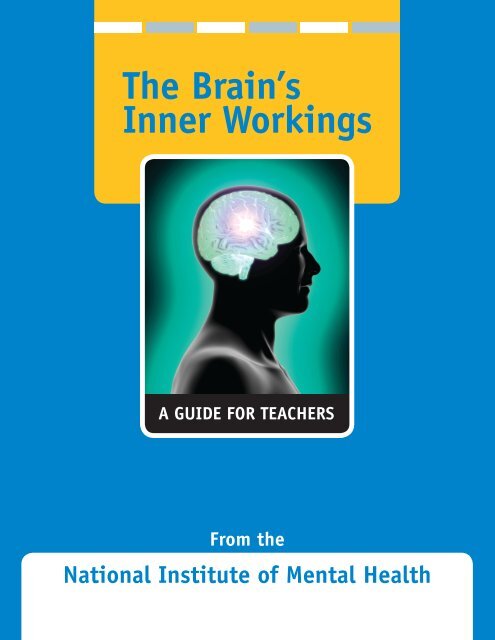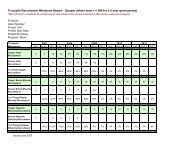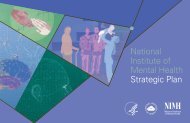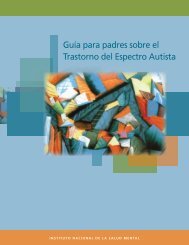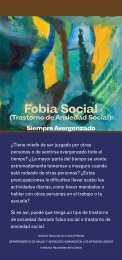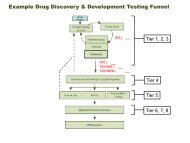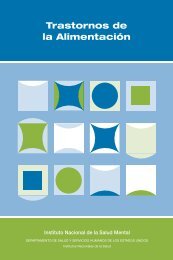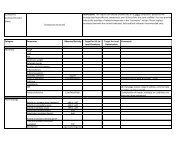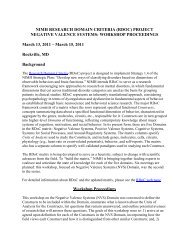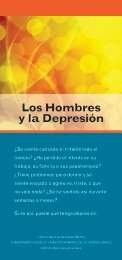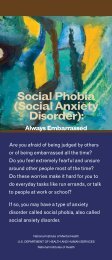Brain's Inner Workings: Teacher's Manual - NIMH
Brain's Inner Workings: Teacher's Manual - NIMH
Brain's Inner Workings: Teacher's Manual - NIMH
Create successful ePaper yourself
Turn your PDF publications into a flip-book with our unique Google optimized e-Paper software.
The Brain’s<br />
<strong>Inner</strong> <strong>Workings</strong><br />
A GUIDE FOR TEACHERS<br />
From the<br />
National Institute of Mental Health
2 The Brain’s <strong>Inner</strong> <strong>Workings</strong>: A Guide for Teachers<br />
NATIONAL INSTITUTE OF MENTAL HEALTH
Table of Contents<br />
Modern Neuroscience Education.......................................................................... 2<br />
Curriculum Part I<br />
Signals, Senses, and Survival.............................................................................. 4<br />
Visualizing the Nervous System.......................................................................... 6<br />
The Brain’s <strong>Inner</strong> <strong>Workings</strong> Video Part I: Structure and Function............................. 7<br />
Keeping in Touch.............................................................................................. 8<br />
Walking the Tightrope....................................................................................... 9<br />
Teacher’s Guide to Activity: The Neuron..............................................................11<br />
Extra Background: Reviewing Neuron Ultrastructure.............................................12<br />
Teacher’s Guide to Activity: Signs and Signals.....................................................13<br />
Extra Background: Membranes and Messages.......................................................14<br />
Teacher’s Guide to Activity: Take That!...............................................................15<br />
Teacher’s Guide to Activity: It’s the Thought that Counts......................................16<br />
Curriculum Part II<br />
The Alchemy of Life.........................................................................................18<br />
Teacher’s Guide to Activity: Use Your Brain!........................................................21<br />
The Brain’s <strong>Inner</strong> <strong>Workings</strong> Video Part II: Cognition.............................................23<br />
Teacher’s Guide to Activity: All Together Now......................................................25<br />
Extra Background: Learning for Life...................................................................26<br />
Teacher’s Guide to Summative Assessment: It Takes a Community..........................27<br />
Neuroscience: Today, Tomorrow, and the Future...................................................28<br />
Appendix: Correlation to Common Middle and Secondary Textbooks.......................29<br />
National Institute of Me nt a l Health<br />
The Brain’s <strong>Inner</strong> <strong>Workings</strong>: A Guide for Teachers 1
Modern Neuroscience Education<br />
Most biology courses begin by asking students to define “life”—a task that challenges even the most<br />
experienced researchers. Students often offer descriptions of structures they’ve seen (“cells”) or<br />
physiological processes (“breathing”) that reflect their limited experience with the diversity of the<br />
living world.<br />
Yet the most essential elements of living things are often the hardest for beginning life science students to<br />
conceptualize. At the most basic level, the list includes:<br />
• Living things use energy to maintain their organization and structure;<br />
• Living things can replicate themselves;<br />
• Living things can evolve; and<br />
• Living things respond to their environment to preserve balance (homeostasis).<br />
The fourth characteristic, response (or more technically, irritability), is crucial. It is intuitive once students<br />
begin to consider their own observations of the natural world. Yet it is the one that is covered least thoroughly<br />
in most secondary programs. The framers of the National Science Education Standards clearly defined<br />
behavior as one of the most important goals of secondary life science:<br />
CONTENT STANDARD C: As a result of their activities in grades 9-12,<br />
all students should develop understanding of:<br />
• The cell<br />
• Molecular basis of heredity<br />
• Biological evolution<br />
• Interdependence of organisms<br />
• Matter, energy, and organization in living systems<br />
• Behavior of organisms<br />
THE BEHAVIOR OF ORGANISMS<br />
• Multicellular animals have nervous systems that generate behavior. Nervous systems are formed from<br />
specialized cells that conduct signals rapidly through the long cell extensions that make up nerves.<br />
The nerve cells communicate with each other by secreting specific excitatory and inhibitory molecules.<br />
In sense organs, specialized cells detect light, sound, and specific chemicals and enable animals to<br />
monitor what is going on in the world around them.<br />
• Organisms have behavioral responses to internal changes and to external stimuli. Responses to external<br />
stimuli can result from interactions with the organism’s own species and others, as well as environmental<br />
changes; these responses either can be innate or learned. The broad patterns of behavior exhibited<br />
by animals have evolved to ensure reproductive success. Animals often live in unpredictable environments,<br />
and so their behavior must be flexible enough to deal with uncertainty and change. Plants also<br />
respond to stimuli.<br />
• Like other aspects of an organism’s biology, behaviors have evolved through natural selection.<br />
Behaviors often have an adaptive logic when viewed in terms of evolutionary principles.<br />
• Behavioral biology has implications for humans, as it provides links to psychology, sociology,<br />
and anthropology.<br />
http://www.nap.edu/readingroom/books/nses/6e.html#ls<br />
2 The Brain’s <strong>Inner</strong> <strong>Workings</strong>: A Guide for Teachers<br />
Na t i o n a l Institute of Me n t a l He a l t h
The National Science Education Standards emphasize that important concepts should be explored in depth,<br />
over time, and in a variety of contexts. Students should learn about behavior by relating structure to<br />
function, using the processes of inquiry and aiming toward the goals of scientific literacy. Information about<br />
behavior, from the basics of the nervous system to memory and learning often comes in small, discrete<br />
packages, without the sorts of scaffolded connections that would make it meaningful and authentic.<br />
A strong foundation in the structure and function of the human nervous system offers students the framework<br />
for not only constructing understanding of physiology and homeostasis, but the ability to make good<br />
personal and community decisions about their behaviors in the future. It helps them look at the “implications<br />
for humans,” including the role of the nervous system in learning and community health.<br />
A thorough background in the function of the nervous system can also lead to a better understanding of<br />
brain disease, from chronic behavioral syndromes like ADHD to degenerative conditions like Parkinson’s<br />
Disease. Since almost every family is challenged to care for and get appropriate medical help for members<br />
with brain disease at some point, building knowledge, skills and attitudes about these topics is important.<br />
Constructing an Understanding of Behavior<br />
In order to provide the environment and experiences through which students can construct strong and<br />
authentic concepts about behavior, most secondary programs need supplemental materials beyond the<br />
textbooks.* This module is intended to support traditional curricula in the middle and secondary schools,<br />
to achieve that goal. Included in the program are:<br />
• This Teacher’s Guide, with content background and a proposed pedagogy for the use of the<br />
material;<br />
• Student pages available in text and on an accompanying CD ROM. The student pages include both<br />
text and activities;<br />
• Two outstanding video supplements from <strong>NIMH</strong>, The Brain’s <strong>Inner</strong> <strong>Workings</strong> I and II, introducing<br />
the structure of the nervous system and the role of neurotransmitters in health and disease;<br />
• Student activities to complement the visuals on the <strong>NIMH</strong> video;<br />
• Formative and summative assessments;<br />
• Additional resources on CD including animations;<br />
• A short computer program on the CD called “React,” which can be used to support the laboratory<br />
activities in the Student Resource or to help students extend their understanding by conducting<br />
independent research of their own.<br />
*Correlations to the major secondary textbooks are provided in the Appendix.<br />
National Institute of Me nt a l Health<br />
The Brain’s <strong>Inner</strong> <strong>Workings</strong>: A Guide for Teachers 3
I. Signals, Senses, and Survival<br />
At the most basic level, organisms must respond to survive. Signals can be physical (light, touch,<br />
pressure, gravity), chemical, or electrical. The primary structure that is responsible for response is the<br />
cell membrane. Even the simplest cells that exist today have specialized membranes that respond to<br />
changes in the environment. (It’s primarily differences in the structure of membranes that separates life into<br />
its three great domains, Archaea, Bacteria and Eukarya.)<br />
The first reading in the Student Guide asks students to consider the familiar situation of ants that follow a<br />
chemical trail. It’s a phenomenon many students will have observed, even though they may not have thought<br />
much about what was actually happening. Ants follow a set pattern unless the trail is disrupted. The student<br />
guide asks: “What sort of messages are they sending? How could you test your hypothesis?”<br />
Allow students to brainstorm before they continue to read the text. While some students may know that the<br />
signals are chemical (and of course, there are hints in the sidebar) there are other reasonable hypotheses:<br />
• Students may know that bees communicate by a “dance” and may suggest the ants communicate<br />
in the same way.<br />
• Students may assume that the ants are not following one another, but are following another<br />
signal in a uniform way, such as a scent, visual, auditory, or even magnetic signals.<br />
Safety Note<br />
The sidebar in the student guide<br />
suggests using window cleaner<br />
as a potential solvent for a<br />
hypothetical chemical signal<br />
between the ants. We have not<br />
suggested anything stronger for<br />
safety reasons. Remember that all<br />
chemicals in classrooms require<br />
MSDS information.<br />
Once students have discussed potential signals among ants, ask<br />
them if they know of any other animals that send chemical signals<br />
to one another. Common examples are musk (tail glands in deer),<br />
urine (marking territory in dogs), and odors (like primates in heat).<br />
Of course, ants are multicellular organisms and individuals. Their<br />
ability to coordinate response is quite different than cells. But<br />
this familiar process can provide a simple analogy to the chemical<br />
signals that cells send to other cells. This example is used to<br />
stimulate discussion and to help students analyze their preconceptions<br />
before they begin to look at how the cells of complex<br />
organisms such as humans work together. Encourage students to<br />
speculate not only on how ants communicate, but on what sorts of<br />
experiments might be done to explore this function.<br />
From tiny animals to tiny cells, the analogies continue. Students look at the classic experiment of Theodor<br />
Engelmann. This is described in order to illustrate how individual cells can respond to chemical messages.<br />
This experiment is difficult to replicate in the classroom because few students have the microscope skills to<br />
discern the E. coli while maintaining the depth of field needed for filamentous algae. But it’s worth exploring<br />
in depth, both because it shows coordination and control among individual cells, and because you can use it<br />
to review the basics of cellular response.<br />
4 The Brain’s <strong>Inner</strong> <strong>Workings</strong>: A Guide for Teachers<br />
Na t i o n a l Institute of Me n t a l He a l t h
After students have observed the experiment in enough detail to understand its variables and results, ask<br />
students: “How can the E. coli sense the area of the algae that is photosynthesizing most quickly?” Students<br />
may first suggest either that the bacteria “see” the light or “taste” the products of the photosynthesis reaction.<br />
Review the general (net) reaction for photosynthesis:<br />
Carbon dioxide + Water — Oxygen + (Sugar)<br />
Then ask students if they could taste oxygen in<br />
water. (This may require a bit of thought; “flat”<br />
water that has been heated then cooled does taste<br />
different, and when students recognize that they<br />
often realize that dissolved oxygen is very important<br />
in water.) Another equally likely possibility, from<br />
the standpoint of student understanding, is that<br />
water with less carbon dioxide in it tastes different.<br />
(Remind students of the difference between “flat”<br />
soda and fresh.) Once they are clear that the stimulus<br />
is a chemical analogous to a taste, students can<br />
brainstorm how responding<br />
together (like ants) is an<br />
advantage to bacteria.<br />
Making Our Own Misconceptions<br />
Many of the experiments students do in class<br />
actually contribute to student misconceptions.<br />
One example is building “all purpose” models<br />
of animal cells. Another is the use of passive<br />
materials like egg shell membrane or dialysis<br />
tubing to illustrate cell membranes. In fact, very<br />
few of the functions of membranes are passive.<br />
The pores of membranes expand and contract<br />
based on the environment, and this requires<br />
enzymes and energy for response.<br />
Image Source: http://<br />
www8.nos.noaa.gov/<br />
coris_glossary/<br />
index.aspx?letter=f<br />
For students who suggest that the E. coli may be reacting to the light rather than<br />
the photosynthetic reaction, ask them to suggest an experiment. (The bacteria do<br />
not move to various areas when the alga is not there.) Finally, ask students how the<br />
bacteria move toward the stimulus. If students are not familiar with the ultrastructure<br />
of the bacterial cell, a picture will help the discussion. (Remind students that bacteria<br />
have flagella, but these are not controlled by contractile proteins like the more<br />
complex flagella of Euglena.)<br />
Probe Further:<br />
How specifically might the bacterial cells react to this change in their environment? With a little consideration,<br />
students who have studied the parts of a general cell might be able to offer some general suggestions:<br />
• The environment changes the membrane;<br />
• Changes in the membrane result in changes inside the cell;<br />
• Changes inside the cell result in changes in the movement of the bacterial flagellum.<br />
This is a good place to challenge students with an open question: If individual bacterial cells can work<br />
together to respond to signals, how can the individual cells in your body work together for the same purpose?<br />
To provide wait time, ask students to journal their responses or contribute to an online discussion thread<br />
before the class moves on.<br />
National Institute of Me nt a l Health<br />
The Brain’s <strong>Inner</strong> <strong>Workings</strong>: A Guide for Teachers 5
Visualizing the Nervous System<br />
Continue with the 5-minute video The Brain’s <strong>Inner</strong> <strong>Workings</strong> Part I. This introductory video narrated by<br />
Leonard Nimoy provides outstanding visuals to introduce students’ study. The following brief summary<br />
can provide some suggestions for discussion: The video begins with a collage of learned responses. This<br />
is a good segment to view, discuss, then repeat. It sets the tone for the more technical material that follows.<br />
A student plays piano, kicks a ball, plays chess. Brainstorm: What are the stimuli involved? (Sight, sound)<br />
What are the responses? (Muscle movements, higher cognitive functions) What must be learned? Is any of<br />
the activity inborn or instinctive? (A blink or a reflex as a ball approaches could be inborn, but most of the<br />
actions are learned.)<br />
The narrator then speculates on what “makes humans human?” and attributes that quality to the brain’s<br />
cerebral cortex. This is another great place for students to brainstorm their own definitions of activities that<br />
might be functions of a human brain:<br />
• Tool use? It’s also found in other primates and birds.<br />
• Culture? The passing down of behaviors through social connections has been documented<br />
in many animals including cetaceans.<br />
• Emotions? Many new studies show emotional responses in animals such as dogs<br />
and elephants.<br />
Yet all of these animals, like humans, have complex brains with folded cerebral cortexes. The extent of<br />
folding seems to correspond at least to some degree with intelligence. The narrator suggests that the folding<br />
is a way to create more surface area in a limited space. First, ask students: “Why is the space limited?” Two<br />
logical reasons will easily be generated: There is a physical limit to the weight of the head, and the size of<br />
the head is limited by the need to pass through the birth canal in hips which are functional for walking.<br />
Students may suggest other reasons, such as to turn the head for defense.<br />
The video next moves to show the structure of neurons within the brain. Students may be familiar with<br />
a drawing of a neuron with one long axon and one or two short dendrites; they may be surprised by the<br />
many contacts among these cells. Key terms in the video (Cerebrum, cortex, neuron, axon, dendrite,<br />
process, synapse and synaptic vesicle) are defined in the glossary. The video ends with a summary of why<br />
this research—and the student explorations which will follow—are important. Ask students if they’ve had<br />
any experience with brain disease, and indicate that they will learn more in the activities that follow. The<br />
student guide helps focus their work on decision-making skill.<br />
Don’t expect students to get every detail of the video on first viewing. Its five-minute format makes it ideal<br />
for repeat viewing. The worksheet provided on the next page only asks for general observations. Then return<br />
to the video again. Students will undoubtedly find more to notice on second viewing. You can review the<br />
structure of the neuron in the “Nerves” animation on the companion CDROM.<br />
Finally, the students can explore simple reflexes in the activity Take That!<br />
6 The Brain’s <strong>Inner</strong> <strong>Workings</strong>: A Guide for Teachers<br />
Na t i o n a l Institute of Me n t a l He a l t h
The Brain’s <strong>Inner</strong> <strong>Workings</strong> Video Part I:<br />
structure and function<br />
Study Guide<br />
1. Watch the beginning of the video carefully. Can you play an instrument? Kick a ball? Play chess?<br />
Are these inborn or learned skills? Learned skills.<br />
2. Why should we study normal brain function? To understand abnormal/disease.<br />
3. If you could see the cerebrum, what structural features would you note? The surface is “grey<br />
matter,” two hemispheres, (myelinated) with many folds to increase surface area.<br />
4. How many connections does a single nerve make? Thousands.<br />
5. Why is the cortex folded? To increase surface area in a limited space.<br />
6. What is a dendrite? A process (extension) of a neuron that receives messages.<br />
7. What is an axon? A process (extension) of a neuron that sends messages.<br />
8. How are dendrites similar to axons? How are they different? Use a Venn diagram:<br />
Dendrites<br />
receive messages.<br />
Respond to<br />
neurotransmitters.<br />
Both are<br />
processes<br />
that extend<br />
from the<br />
cell body.<br />
Axons conduct<br />
messages away<br />
from the cell body.<br />
Release<br />
neurotransmitters.<br />
Sending Cell<br />
9. What is a synapse? A gap.<br />
10. Label the parts of the synapse. See labels on diagram.<br />
11. Why should we study a synapse? Many diseases seem<br />
to be related to malfunction of synapses.<br />
12. What is a synaptic vesicle? A structure that contains a<br />
neurotransmitter.<br />
13. What happens when a stimulus reaches a synaptic<br />
vesicle? Neurotransmitters are released; chemical<br />
messages are sent.<br />
Transporter<br />
Neurotransmitter<br />
Receiving Cell<br />
Vesicle<br />
Receptor<br />
molecules<br />
Synapse<br />
Image source: http://www.nida.nih.<br />
gov/NIDA_notes/NNvol21N4/cell.gif<br />
14. What happens if an error occurs in this process? The message may be garbled; disease occurs.<br />
15. What new information do you want to know about the brain? Answers will vary.<br />
National Institute of Me nt a l Health<br />
The Brain’s <strong>Inner</strong> <strong>Workings</strong>: A Guide for Teachers 7
Keeping In Touch<br />
Next, students move from coordination among organisms to coordination with<br />
the cells of multicellular organisms—with an emphasis on animals. Almost*<br />
all animals coordinate their responses through the action of specialized cells<br />
called neurons. These are cells that are specialized to receive information, encode<br />
it into electrical or chemical signals, and transmit that information to other cells.<br />
They are the most basic units of structure within the nervous system.<br />
*Almost All Animals?<br />
The simplest animals (Kingdom<br />
Metazoa) are the Placazoans, and<br />
we know almost nothing about<br />
them. They’ve been found on<br />
the walls of aquaria but never in<br />
the wild. Poriferans don’t have<br />
nervous systems, but most other<br />
animals do.<br />
cells in the nervous system, but not the most numerous. In<br />
many animals, there are perhaps ten times more glial cells than<br />
neurons. They come in many forms and have a variety of functions;<br />
they may support and orient neurons, or insulate them<br />
from the environment. Oligodendrites and Schwann cells wrap<br />
around axons nourishing them. They produce myelin, a covering<br />
that insulates the axon and makes the tissue appear white (i.e.,<br />
“white matter” vs “grey matter”).<br />
Most textbooks discuss the nervous systems<br />
of higher animals, but rarely offer discussions of the simplest nervous<br />
systems. Students will benefit by beginning with the genetics of<br />
the roundworm Caenorhabditis elegans. This organism is a favorite<br />
of biologists because it has only a few cells (~1000). Great details<br />
of research about this popular organism can be found at<br />
http://weboflife.nasa.gov/celegans/questionsshow.htm.<br />
Most students have studied a generic model of an animal cell. But<br />
they may not realize that there are at least 100 distinct types<br />
of differentiated cells in the bodies of most higher animals. (We<br />
actually create misconceptions by stressing a generic cell model and<br />
de-emphasizing differentiation.) Neurons are the most recognizable<br />
Researchers are exploring the<br />
potential of oligodendrites to<br />
differentiate into neurons. Clinical<br />
trials are underway to see if cultures<br />
of nasal oligodendrites can be<br />
transplanted to repair damage to the<br />
nerves in spinal cord injuries.<br />
8 The Brain’s <strong>Inner</strong> <strong>Workings</strong>: A Guide for Teachers<br />
Na t i o n a l Institute of Me n t a l He a l t h
Walking the Tightrope<br />
The essential challenge of multicellular life is coordination. The reading Walking the Tightrope begins<br />
with a comparison among very simple Metazoa, the sponge and the anemone. Like the examples of<br />
bacteria and ants, these images are meant to help students think about responses in a very simple way,<br />
and to isolate the function of irritability so that they can develop deeper understanding of the content. Then<br />
four explorations are provided for students. While completing all of them is ideal, students can explore all<br />
the core concepts by completing two: The Neuron and Take That!<br />
The activity The Neuron is meant to accompany either microscope or<br />
video observations of neurons, experiences included in almost every<br />
middle and high school course. If the facilities exist, allow students<br />
to view prepared microscopic slides of neurons in conjunction with<br />
the reading passage Membranes and Messages, which provides a very<br />
brief introduction to the action potential and its relationship to the<br />
neuronal membrane.<br />
Safety Note:<br />
Make sure students understand<br />
they are looking for touch—not<br />
pain—receptors.<br />
Take very great care that<br />
students’ eyes are protected in<br />
the Take That! activity.<br />
During the observation it is assumed that students have some<br />
knowledge of microscopic stains. (If they have only used iodine, it’s<br />
worthwhile to explain that stains bond to specific kinds of molecules and highlight specific parts of cells<br />
and tissues.) It is also assumed that students have a rudimentary knowledge of cell ultrastructure, including<br />
organelles such as nucleus, mitochondria, endoplasmic reticulum, and cell membranes. A review is included<br />
below if you don’t have one in your textbook. Emphasize the difference between free ribosomes and those<br />
that are bound to the endoplasmic reticulum, and the link between free ribosomes and membrane proteins.<br />
The reading selection, Does the Nose Know? provides background on how stimuli affect cell membranes.<br />
Remember, many of the textbooks and lessons your students will have experienced will have shown<br />
membranes as passive structures. In fact, when asked “What is the most important part of the cell?” most<br />
students say “the nucleus.” But the most essential component of a cell is its membrane and most cells on<br />
Earth lack nuclei. Even a few cells in human bodies (mature red blood cells) lack nuclei. They can’t repair<br />
themselves, but can survive and even thrive for relatively short periods of time. But without a membrane to<br />
control its internal environment and allow it to respond, the cell cannot live at all.<br />
Next, students explore the distribution of their own sensory neurons in their skin in the activity Signs and<br />
Signals. This activity asks students to look at the distribution of touch sensors in various areas of their skin.<br />
The “two point discrimination test” is not highly accurate, but the range of differences among areas of the<br />
body is so great that good results are usually easy to obtain.<br />
National Institute of Me nt a l Health<br />
The Brain’s <strong>Inner</strong> <strong>Workings</strong>: A Guide for Teachers 9
Finally, students can explore the “simple” reflexes in the activities Take That! and It’s the Thought that<br />
Counts. This section of the module includes two simple computer programs for measuring reaction time.<br />
They are only roughly accurate, but again the results are proportional to those obtained by more specialized<br />
equipment. Professional researchers know that the display of most personal computers creates inherent errors<br />
in reaction time measurement, but these errors are too small to contribute to misunderstandings at this level.<br />
Some reflexes are coordinated in the spinal cord, where grey matter (unmyelinated neurons) connect sensory<br />
and motor neurons. Other reflexes like blinking are coordinated in the midbrain. While scientists hesitate to<br />
classify reflexes as “simple” any more, reflexes are defined as “instantaneous,” so autonomic responses that<br />
take longer (like the “butterfly” reaction that occurs a few moments after a scare, due to less blood flow to<br />
digestive system) are technically not reflexes but the results of neurotransmitters.<br />
There are also many types of movement that scientists consider “stereotypical,” that defy easy classification<br />
for beginning students. For example, animals with their spinal cord completely transected have been<br />
observed to make well coordinated walking movements as a result of exposure to certain neurotransmitters—<br />
without any conscious control by the brain. The mystery of how molecules interact with cells to produce the<br />
most basic behaviors necessary for an organism to survive is far from solved.<br />
These activities are meant to help students transition from an understanding of simple and relatively linear<br />
responses to the more complex balance of responses that occur in the nervous system as the result of the<br />
interaction of many neurons and neurotransmitters. They can also form the basis for more extensive independent<br />
research with the help of the computer programs.<br />
Explore the speed of a nervous system in the “How Fast” animation on the companion CDROM, and then see<br />
how a simple reflex works in the “Reflexes” animation on the companion CD. Then return to a discussion of<br />
the very complex cognitive functions that were first introduced in the video. There is a great deal of difference<br />
between a blink or reflexive defense and a complex action like playing piano, making a goal in soccer or<br />
checkmating one’s opponent. Yet they are all built of the same basic chemical and electrical messages that<br />
are represented in the model of a simple reflex.<br />
10 The Brain’s <strong>Inner</strong> <strong>Workings</strong>: A Guide for Teachers<br />
Na t i o n a l Institute of Me n t a l He a l t h
Teacher’s Guide to Activity<br />
The Neuron<br />
Can you imagine the size of a single neuron? The tip<br />
of a dull pencil is about 2 mm across. Make a dot<br />
in the space above. The cell body of a neuron is<br />
closer to 0.02 mm. Can you calculate how many average<br />
cell bodies would fit in the dot you’ve drawn? Use an<br />
arrow and label your dot: “______ neurons could fit in this<br />
spot.”<br />
Dendrites<br />
Cell Body<br />
Axon<br />
Myelin<br />
sheath<br />
Of course, your estimate can’t be very accurate. Neurons<br />
aren’t dots. They are highly differentiated cells with<br />
membranes and processes that are specifically adapted<br />
for their function. Biologists didn’t always understand that,<br />
though.<br />
Image Source: http://www.nida.nih.gov/JSP4/MOD1/<br />
images/neuron1.gif<br />
To see the bodies of cells under the microscope, we normally use special chemicals called stains that bind<br />
to specific organelles in the cell. The first effective stain for neurons was developed by German neurologist<br />
Franz Nissl about 1880. A few years later, an Italian histologist, Camillo Golgi, discovered that a different<br />
sort of stain would also reveal neurons. But with Golgi’s stain, the neurons looked very different. Look at<br />
the chart below. Compare the structures revealed by the methods of Nissl and Golgi. Then form a hypothesis.<br />
What cell organelles are binding to the two very different stains?<br />
Stain Appearance Chemical Organelles<br />
Nissl<br />
Cresyl violet<br />
Nissl bodies include granular<br />
endoplasmic reticulum and<br />
ribosomes.<br />
Golgi<br />
Silver nitrate and<br />
potassium chromate<br />
Stains membranes of (some)<br />
axons and dendrites.<br />
Golgi’s work was revolutionary, but it was left to a younger researcher, Spaniard Santiago Ramon y Cajal,<br />
to use the technology to its fullest. In an amazing series of dissections, he revealed the structure of much<br />
of the nervous system. Golgi believed that neurons were all linked (like blood vessels). Cajal believed that<br />
brain cells touched one another, but only at specific locations called synapses. Who was proved right in the<br />
end? What evidence can you give for your answer? Modern microscopes have more resolution; they show<br />
that the axon of one dendrite does not quite touch the dendrite(s) of the next. At the synapse the signal<br />
changes from electrical to chemical in most nervous systems. (Teacher note: This is not true in every<br />
nervous system. There are some where the gap junction is electrical. Electrical synapses are common in<br />
invertebrates, but found in only a few locations in mammals where coordination must be extremely fast<br />
and well coordinated).<br />
National Institute of Me nt a l Health<br />
The Brain’s <strong>Inner</strong> <strong>Workings</strong>: A Guide for Teachers 11
Extra Background<br />
Reviewing Neuron Ultrastructure<br />
Many students can benefit from a review of the<br />
structure of the highly differentiated neuron.<br />
The typical neuron is about 20 μm in diameter. Like<br />
most other cells, it has a nucleus that is about 5-10<br />
μm in diameter.<br />
Dendrites<br />
Cell Body<br />
Axon<br />
Myelin<br />
sheath<br />
In the cell, proteins are synthesized on ribosomes.<br />
Some float free in the cell; others are bound to the<br />
membranes of “rough” endoplasmic reticulum (ER).<br />
Both types of ribosomes are involved in protein<br />
synthesis, but the proteins that are destined to be bound to<br />
the cell membrane are normally produced on the rough ER.<br />
Image Source: http://www.nida.nih.gov/JSP4/MOD1/<br />
images/neuron1.gif<br />
The cytosol of neurons is especially rich in rough ER. (That’s what makes many neurons very reactive to the<br />
Nissl stain). That’s a clue that the production of membrane proteins and neurotransmitters is a key function<br />
in neurons. It’s a great example of structure providing clues to function. (Ask students: “If Nissl stain shows<br />
a great deal of rough endoplasmic reticulum, what does that suggest about the neuron’s metabolism?)<br />
Proteins that will eventually end up in the axon are further processed by the Golgi apparatus, since there is<br />
no protein synthesis in the cell processes. So Golgi are also notable in neuron ultrastructure.<br />
Neurons are high-energy cells, and accordingly have a high level of mitochondria. Relatively large microtubules<br />
run down the length of the cell helping it maintain its overall structure. A specific change to the<br />
microtubule-associated protein, Tau, is associated with the dementia that accompanies Alzheimer’s disease.<br />
Tau holds the microtubules in order; without it the shape of the dendrites change.<br />
Neurons can be classified by the general shape determined by their dendrites: pyramidal or stellate (star<br />
shaped). They can also be classified by their connections: sensory or motor; or classified by the neurotransmitter<br />
released by their synapses.<br />
But the most remarkable functions of neurons are directly associated with their membranes. That’s the<br />
content summarized in the Student Reading Membranes and Messages.<br />
12 The Brain’s <strong>Inner</strong> <strong>Workings</strong>: A Guide for Teachers<br />
Na t i o n a l Institute of Me n t a l He a l t h
Teacher’s Guide to ACtivity<br />
Signs and Signals<br />
Every organism must be able to sense the environment.<br />
This almost always occurs through cell membranes.<br />
You’ll learn more about membranes in the next reading.<br />
But before you do, you can explore one special system of<br />
sensation in a simple yet accurate way.<br />
Epidermis<br />
Dermis<br />
Blood vessel<br />
Sensory nerve<br />
Fibroblasts<br />
Hair follicle<br />
In your skin, some of the specialized sensory neurons have<br />
membranes that respond to touch through receptor cells for<br />
Fat<br />
Sweat gland<br />
pain, heat, and cold. Here’s a way to measure them experimentally<br />
with a ruler marked in millimeters and a large paper clip. Separate<br />
the points of the paper clip by 2 cm. Ask a subject to cover his/her<br />
Image source: http://www.nigms.nih.gov/<br />
NR/rdonlyres/0037E7BB-97A3-4EC6-904A-<br />
61CEEE4352EF/0/skin2.jpg<br />
eyes and ask if he/she can feel one or two points on various areas of<br />
their body. Repeat the experiment with the points of the paper clip separated by 1 cm, .5 cm, and .25 cm.<br />
Area 2 cm 1 cm 0.5 cm 0.25 cm<br />
Forearm<br />
x<br />
Cheek x x<br />
Index Finger x x x<br />
Palm of Hand x x<br />
1. In what area were the touch receptors closest? Fingers, hands and cheek.<br />
2. What survival advantage might this difference have? Anthropologists believe that manual<br />
dexterity (use of hands for tools and communication) was an important survival factor in early<br />
hominids. Facial sensitivity is also important for communication and as a sexual stimulus.<br />
National Institute of Me nt a l Health<br />
The Brain’s <strong>Inner</strong> <strong>Workings</strong>: A Guide for Teachers 13
Extra Background<br />
Membranes and Messages<br />
To understand the way neurons work, students must<br />
have a good understanding of the dynamic nature of<br />
the cell membrane. The specializations that occur in<br />
cell membranes are especially important for communication<br />
within multicellular organisms. As explained above, the<br />
standard exercises that students do in elementary or middle<br />
school to explore the permeability of membranes can even<br />
add to these misconceptions.<br />
Plasma<br />
Membrane<br />
Receptor<br />
Hormone<br />
Pathway “On”<br />
x<br />
Pathway “Off”<br />
Image Source: http://publications.nigms.nih.gov/<br />
chemhealth/images/ch4_party.gif<br />
Cell membranes are very active, indeed. If your students have already done experiments with passive models,<br />
it’s a good idea to start there, reviewing the fact that passive transport is not the norm. The picture in the<br />
student guide can illustrate how a neurotransmitter changes the size of pores on a cell membrane.<br />
The size of the pores in cell membranes changes constantly<br />
40<br />
depending upon their environment and internal metabolism.<br />
Simulation<br />
20<br />
Some are voltage-gated; that is, they open or close in<br />
0<br />
-20<br />
response to a change in the voltage across the plasma membrane.<br />
Chemically-gated channels respond to chemicals such<br />
as neurotransmitters.<br />
-40<br />
-60<br />
The reading selection Membranes and Messages provides a very<br />
-80<br />
0 2 4 6 8 10<br />
simple description of an action potential. This is really all<br />
secondary students need to understand. The charge across the<br />
Time (ms)<br />
membrane of a neuron is controlled in part by ion channels.<br />
The control of channels requires both enzymes and energy.<br />
As an analogy, any static electricity demonstration might be used. But remind students that the signal in a<br />
neuron is voltaic (involving charged ions), not directly analogous to circuit electricity.<br />
Action potential (mV)<br />
The example which is provided for control of respiration is one that can become the basis of many anecdotes<br />
and short student explorations. The carotid and aortic bodies contain chemoreceptors which respond to the<br />
oxygen and carbon dioxide concentrations in arterial blood. A carbon dioxide partial pressure of more than<br />
approximately 5kPa, (40mmHg) (depending on age or health), results in an immediate and marked increase<br />
in breathing. Athletes learn about this phenomenon without the basis of physiology. They learn that they<br />
must concentrate on breathing out (more than breathing in) to control blood pH and to prevent hyperventilation.<br />
Remind students that the signal sent by the pacemaker of the heart is also electrical; it can be sensed from<br />
one end of the body to the other as it stimulates and coordinates the contractions of the heart. But that’s<br />
more like current electricity.<br />
14 The Brain’s <strong>Inner</strong> <strong>Workings</strong>: A Guide for Teachers<br />
Na t i o n a l Institute of Me n t a l He a l t h
Teacher’s Guide to ACtivity<br />
Take That!<br />
The simplest responses that organisms make to the environment<br />
are “hard wired” into their nervous systems. Some sensations<br />
trigger responses that occur without any analysis. They only<br />
involve the most primitive parts of the nervous system. You reach out<br />
and touch a thorn. You pull back without thinking about it at all! The<br />
message goes from sensory neuron to a connecting neuron in the spinal<br />
cord, and then to a motor neuron that moves a muscle. Explore:<br />
1. Obtain two sheets of heavy, clear transparency acetate. You’ll<br />
use these as your shield. Hold them up in front of a subject’s<br />
face. Crumple a half sheet of paper into a ball (about the<br />
size of a ping pong ball) and toss it toward the subject’s<br />
face. What is the reaction? The blink reaction is a simple<br />
defensive reflex coordinated in the midbrain.<br />
2. Does the reaction change if the subject knows that the paper<br />
is coming toward his/her face? Only a few people can control<br />
it.<br />
3. If the paper is aimed at one eye, does the other eye react in<br />
the same way? Yes, in most cases.<br />
4. What is the survival advantage of this reflex? It protects eyes.<br />
Image source: http://www.nida.nih.gov/<br />
pubs/teaching/Teaching2/largegifs/slide4.<br />
gif<br />
5. Next, lower the light in a room. Watch the size of your subject’s pupils as you gently shine a small<br />
flashlight toward his/her eyes. What happens? The pupils constrict.<br />
6. Hold a note card parallel to your subject’s nose. If you shine the light in one eye only, how does<br />
the other eye react? In healthy subjects they are coordinated.<br />
7. Now in full light, watch your subject’s pupils again. This time, gently stroke the back of the<br />
subject’s neck. How does this affect pupil size? Pupils dilate.<br />
8. Many of our simple reflexes are remnants of the time when humans were hunters. Think of the<br />
reactions you have to something that scares you (like a movie.) What are your physical responses?<br />
Sympathetic responses include dilated pupils, less blood to digestive system and more to<br />
muscles, increased heart rate and respiration rate.<br />
9. Which of the reactions above happen very quickly (in a second or less)? These are probably<br />
reflexes: While all are autonomic, the pupil dilation is more rapid.<br />
10. Which of the reactions you identified take a little longer (from seconds to minutes)? These<br />
are probably chemical signals. Changes in blood to digestive system are the result of<br />
neurotransmitters.<br />
Some reactions are completely unconscious. Explore how a reflex works in the “Reflexes” animation on the<br />
companion CD. Others aren’t hardwired for survival, but are learned—mediated by our brains. Think of the<br />
first time you brushed your teeth. You probably thought “Left…right…up…down.” But now it’s almost<br />
unconscious. Your teacher will help you explore some learned responses using your classroom computer using<br />
the program “React.”<br />
National Institute of Me nt a l Health<br />
The Brain’s <strong>Inner</strong> <strong>Workings</strong>: A Guide for Teachers 15
TeaCHeR’s GuIDe To aCTIVITy<br />
It’s the Thought that Counts<br />
In the first section of this unit, students explored blink reflexes that were coordinated by the midbrain.<br />
Researchers have found that this survival reflex is anything but simple. It is possible to develop a<br />
“conditioned” eye blink reflex; that is, to resist the impulse to blink and to learn to respond to new<br />
situations when blinking is necessary. In a series of experiments, researchers applied a puff of air near the<br />
eye of a rabbit and simultaneously played a distinctive sound. The rabbit quickly learned to blink when the<br />
sound was heard. This learning appears to be a function of the brain’s cerebellum.<br />
Section of the Spine<br />
Spinal Cord<br />
The second activity begins by describing a simple motor reflex:<br />
When you avoid a prickly cactus or a hot stove, the message<br />
goes from receptor to spine to motor neuron.<br />
Nerve Roots<br />
Vertebra<br />
Intervertebral<br />
disk<br />
In the computer program “React” students explored how<br />
quickly they could recognize a signal and respond with a<br />
simple click. This is not a simple reflex, and students should be<br />
clear why it requires some “intervention” by the brain, but not<br />
much. Then they are asked to take the progression one step<br />
further. In the second section of “React” the subject recognizes<br />
and separates left from right, and then different kinds of shapes.<br />
Compare the average speed achieved for each task, then outline<br />
the path of the stimulus and response for the actions in a simple reflex (such as touching something that<br />
hurts), responding to a signal, and responding to a signal that requires prior knowledge.<br />
Image adapted from: http://diabetes.niddk.nih.gov/dm/pubs/complications_nerves/images/fourparts.gif<br />
16 The Brain’s <strong>Inner</strong> <strong>Workings</strong>: A Guide for Teachers<br />
Na t i o N a l iNstitute of Me N t a l He a l t H
Students should note that a “simple reflex” involving a touch or pain sensor and a motor response moves<br />
from the sensory nerve to the spine, and back along a motor neuron to the muscle.<br />
The three tasks in the React program require analysis and response by the brain at some level. Lines on the<br />
first diagram (showing a simple reflex) should go from finger to spine to finger; on the second diagram, from<br />
finger to spine to brain to finger; on the third, from finger to spine to cerebrum to spine to finger.<br />
Take It Farther<br />
Some biologists believe that the hardest task in sports is the action of a baseball batter hitting a ball. Think<br />
about it: The batter must not only react to an object approaching at over 90 miles per hour, but must have<br />
some knowledge of how that object moves through 3-dimensional space. (And if it’s a curve ball, watch out!)<br />
Some novice players react to the oncoming ball by flinching or blinking. But like the rabbit in the experiment<br />
described above, a good ball player soon conditions his/her blink reflex.<br />
Web Search<br />
The late, great biologist Steven Jay Gould was not only crazy about biology but was one of the most avid<br />
baseball fans ever. What can you find about his use of baseball stories to explain biology?<br />
National Institute of Me nt a l Health<br />
The Brain’s <strong>Inner</strong> <strong>Workings</strong>: A Guide for Teachers 17
II. The Alchemy of Life<br />
While most units on neuroscience begin by discussing electrical signals, chemical messages are<br />
actually more common in multicellular animals. This module began by looking at how the simplest<br />
organisms communicate through chemical signals. Now students can explore the far more complex<br />
system of chemical messages in humans.<br />
The reading selection The Alchemy of Life begins by outlining the basic neurotransmitters that cross synapses<br />
to coordinate response in animals. Students may quickly jump to questions and speculations about other<br />
kinds of chemical messages sent by hormones. Technically, a neurotransmitter is a molecule that is synthesized<br />
in a presynaptic neuron, and produces a response in a postsynaptic cell. So while hormones are certainly<br />
chemical messengers, they aren’t all neurotransmitters in the strict sense of that definition. The chart below<br />
illustrates just a few of the neurotransmitters currently studied in humans.<br />
Many basic textbooks outline the functions of neurotransmitters one at a time, implying that they operate<br />
independently. But it’s clear from modern research that to maintain homeostasis organisms must achieve a<br />
delicate balance among many types of chemical messages. That’s why the section on “chemicals from the<br />
environment” includes a suggestion that students brainstorm a concept map showing the interaction between<br />
various neurotransmitters and body processes.<br />
• Glutamate is the primary neurotransmitter in the central nervous system that is released to<br />
increase the activity of neurons. It is especially important for memory and cognition.<br />
• Gamma aminobutyric acid (GABA) is an inhibitory neurotransmitter, acting to reduce the activity<br />
of neurons.<br />
• Norepinephrine is used by some brain neurons, and by peripheral nerves in the sympathetic<br />
division of the autonomic nervous system. It increases metabolism, respiration, and heart rate.<br />
• Acetylcholine is released by motor neurons and some brain neurons. It is the primary<br />
neurotransmitter in the parasympathetic division of the autonomic nervous system.<br />
• Serotonin (5-hydroxytruptamine) is a “reward” neurotransmitter. The brain cells that release<br />
serotonin help moderate mood swings, limit aggression, and help modify pain.<br />
• Dopamine is another reward neurotransmitter. It helps the brain and body relax, and appears<br />
to help coordinate muscles. Dopamine deficiencies are related to diseases like Parkinson’s and<br />
overactive dopamine pathways are implicated in schizophrenia.<br />
• Histamines (the chemicals that cause your body to respond to cold viruses and allergens) are also<br />
neurotransmitters. And there are many more, including hormones like gastrin, gonadotrophins,<br />
endorphins, glucagons, thyrotropin, and insulin. These aren’t necessarily used to connect nerve to<br />
nerve, but change the membranes of dendrites and thus help coordinate body responses.<br />
18 The Brain’s <strong>Inner</strong> <strong>Workings</strong>: A Guide for Teachers<br />
Na t i o n a l Institute of Me n t a l He a l t h
The Challenge of Chemicals from the Environment<br />
One way to help students begin to conceptualize the dynamic relationship among neurotransmitters is to<br />
have them develop concept maps which include the responses to given environmental challenges. Offer each<br />
group a challenge card, with a situation such as these:<br />
• Someone threatens you in a way that makes you very angry.<br />
• You eat a very heavy meal, and you relax in front of a football game.<br />
• You are surprised by a large spider on the back of your hand.<br />
• You are stung by a large wasp.<br />
• You exercise regularly, running a few miles each morning.<br />
• You are sleeping soundly and an alarm rings.<br />
Once groups have tried one concept map, they might be challenged to invent a situation for another group<br />
to analyze. They can then move on to the more specific hypotheses in the activity All Together Now. Note:<br />
Answers may vary somewhat. Even among individuals of the same species, the exact mix of neurotransmitters<br />
can vary. Students should understand that neurotransmitters must work in a coordinated way.<br />
Sample Concept Map for the reaction to an insect bite:<br />
Histamines are<br />
released as cells<br />
react to bite<br />
Wasp<br />
Stings<br />
You<br />
Epinephrine<br />
speeds heart,<br />
respiration<br />
Serotonin<br />
helps modify<br />
pain and panic<br />
The student reading progresses from a discussion of very mild chemical influences (like coffee and caffeine)<br />
to one that is potentially fatal alcohol abuse. It’s important that students don’t trivialize the comparison.<br />
National Institute of Me nt a l Health<br />
The Brain’s <strong>Inner</strong> <strong>Workings</strong>: A Guide for Teachers 19
Apply and Extend<br />
There are many authentic connections that can be made when students study neurotransmitters. They can<br />
monitor their own responses to common situations like eating, exercise, or scary movies by charting and<br />
comparing blood pressure and heart rate over time.<br />
Another important extension should involve the way that<br />
drugs can alter the way in which neurotransmitters are<br />
released and sensed by cells. The diagram illustrates the<br />
interference of morphine and opiate receptors on the cell.<br />
Another connection involves use of alcohol:<br />
• Alcohol blocks reception of glutamate,<br />
preventing the hippocampus from changing<br />
short-term memories to more permanent ones.<br />
• Alcohol enhances the receptor mechanisms for<br />
GABA, making most people sleepy. But when<br />
chronic drinkers try to quit, they can’t relax<br />
because their nervous systems become used to<br />
the more intense effects.<br />
Game On?<br />
Researchers at Stanford University<br />
School of Medicine are studying how<br />
video games trigger the release of<br />
neurotransmitters in the brain. They<br />
have found that the responses of men to<br />
games was far stronger than the responses<br />
of women. The nucleus accumbens of<br />
their brains sometimes released levels of<br />
neurotransmitters comparable to addiction!<br />
• Serotonin helps the brain moderate moods<br />
and aggression. Alcohol’s effects on serotonin<br />
receptors are thought to be involved in the<br />
rewarding effects of alcohol.<br />
• Dopamine is a reward neurotransmitter.<br />
It’s also one that helps us associate subtle<br />
environmental cues with pleasurable<br />
memories—like “mom’s chicken soup.”<br />
Some pharmacologists believe that the<br />
association of places with past drinking<br />
experiences contributes to craving.<br />
Image source: http://www.nida.nih.gov/pubs/<br />
teaching/Teaching2/largegifs/slide17.gif<br />
All these changes confuse a system that originally<br />
evolved for survival.<br />
For further information on the neurobiology of addiction, go to http://www.nida.nih.gov/pubs/teaching/<br />
Teaching2/Teaching4.html.<br />
20 The Brain’s <strong>Inner</strong> <strong>Workings</strong>: A Guide for Teachers<br />
Na t i o n a l Institute of Me n t a l He a l t h
Teacher’s Guide to ACtivity<br />
Use Your Brain!<br />
In only about 1300 grams of tissue, your brain<br />
has as many as 10 billion neurons and perhaps<br />
10 times that many glial cells to nourish them.<br />
Each neuron can contact more than 1000 others<br />
across their synapses. Imagine all the connections<br />
you could make at one time! But somehow, you are<br />
able to concentrate and focus on a single task. Here’s<br />
an activity students can use to investigate how they<br />
learn, and their ability to concentrate. It can also be<br />
used as a post-viewing activity for the second video,<br />
since research with rat mazes is featured.<br />
To complete the activity, students will need colored<br />
pencils, a clock with a second hand, an MP3 player and a jar of crushed garlic (or other strong odor that is<br />
non-toxic and unlikely to stimulate allergies). Appoint one student in each group to be the Primary Investigator.<br />
In a quiet setting each member of the team tries a maze and records the baseline time required for completion.<br />
This step is to provide a standard and practice timing. From the Web site http://www.onebillionmazes.com/?t=0<br />
print out 4 copies of each of the first four mazes for each group. Mark the number of the maze on the back.<br />
The PI distributes mazes at random to the 4 subjects in the group upside down and determines the time for<br />
each group member to complete the first maze. For step 2, the PI times each subject on a different maze while<br />
providing a distraction, in the form of music. For step 3, each subject must sing his/her favorite song while<br />
solving a third maze. For step 4, the PI opens a jar of garlic to provide a strong odor as a distraction as the<br />
mazes are solved. Students record the times on this chart:<br />
Subject Maze Only With Music While Singing With Odor<br />
Average Time<br />
National Institute of Me nt a l Health<br />
The Brain’s <strong>Inner</strong> <strong>Workings</strong>: A Guide for Teachers 21
1. The mazes from the Web site aren’t<br />
guaranteed to be of equal difficulty.<br />
What technique did you use to try to<br />
minimize this source of error?<br />
Averaging and random assignment of<br />
mazes minimizes error.<br />
2. Use the diagram at the right to indicate<br />
which parts of the brain were involved<br />
in the tasks: shade the areas required to<br />
do the basic maze in grey (pencil), the<br />
area that analyzes music in red, the area<br />
that generates speech in blue, and the area<br />
that responds to odors in green.<br />
Image source http://pubs.niaaa.nih.gov/publications/<br />
aa63/images/brain.gif<br />
Students should realize that many areas of the brain must work together to solve a maze. The occipital<br />
lobe is responsible for vision, the parietal lobe is the center of visual attention and goal-directed<br />
voluntary movements, and the cerebellum for fine motor coordination. Broca’s area (for speech) is located<br />
in the inferior frontal gyrus. The temporal lobes are responsible for hearing. Odor is detected by the<br />
piriform cortex, a portion of the primary olfactory cortex.<br />
It’s also important for students to realize that the mazes may be only approximately equal in difficulty.<br />
Some subjects could be right- or left-dominant, and find certain turns easier to perceive than others. Only<br />
a large number of subjects would reduce this source of error.<br />
Some of the first quantitative studies of the<br />
performance of rats in mazes were completed by<br />
American psychologist Karl Lashley in the 1920s.<br />
Lashley would allow a rat to complete a maze to get<br />
food again and again. He would then create lesions<br />
in various areas of the cerebral cortex, and then<br />
measure whether the rat could still complete the<br />
maze. But Lashley thought that all areas of the cortex<br />
were more or less equivalent. His student, Donald<br />
Hebb, began the work to localize specific cortical<br />
areas for vision, hearing, and spatial discrimination.<br />
22 The Brain’s <strong>Inner</strong> <strong>Workings</strong>: A Guide for Teachers<br />
Na t i o n a l Institute of Me n t a l He a l t h
The Brain’s <strong>Inner</strong> <strong>Workings</strong> Video Part II:<br />
cognition<br />
Study Guide<br />
The first video traced the path of a message down a single row of neurons. In this video you think about<br />
how neurons work together.<br />
1. What is “higher order thinking?” Problem-solving, creative thinking.<br />
2. Give some examples of higher order thinking tasks that have challenged you today: Answers will<br />
vary; finding a route around a detour, passing a test, getting a new friend to respond, fixing a<br />
broken tool, writing a poem or an essay.<br />
3. Many scientists use laboratory rats to study behavior. Use the Venn diagram below to think about<br />
how rat behavior might be similar and different to that of humans in a maze.<br />
Rats have a<br />
different balance<br />
among senses,<br />
different survival<br />
priorities.<br />
Both have<br />
the same<br />
neurotransmitters<br />
and approximately<br />
the same<br />
brain structure.<br />
Humans can<br />
understand the<br />
motivation of the<br />
experiment and<br />
sometimes<br />
“overthink.”<br />
The study of brain function has changed dramatically since scientists began to use functional magnetic<br />
resonance imaging (fMRI) and positron emission tomography (PET) scanning. What advantage do these<br />
techniques give over previous “in vitro” examinations of human brains? We can now study healthy brains of<br />
people doing normal, every day functions.<br />
4. Use the video and outside sources to identify the<br />
parts of the brain.<br />
1. cerebellum<br />
2. cerebrum<br />
3. frontal lobes<br />
4. motor area<br />
5. Broca’s area (language)<br />
6. parietal lobes<br />
7. sensory lobes<br />
8. occipital lobes<br />
9. temporal lobes<br />
5<br />
3<br />
2<br />
1<br />
4 7<br />
Image Source: http://www.ninds.nih.gov/disorders/<br />
brain_basics/know_your_brain.htm#art<br />
6<br />
9<br />
8<br />
National Institute of Me nt a l Health<br />
The Brain’s <strong>Inner</strong> <strong>Workings</strong>: A Guide for Teachers 23
5. From a functional standpoint, how is the brain of a person with schizophrenia different? (You may<br />
wish to use the reading on page 25 for further information.) The brain processes information<br />
differently. There are several lines of evidence that suggest malfunctions in dopamine<br />
transmission.<br />
A Note on Sensitivity and Stigma:<br />
Whenever groups of students study brain disease, there is the possibility of reaching someone for whom the<br />
problems are very personal. Despite progress in society’s recognition of the nature and challenges of brain<br />
disease, there is still stigma surrounding brain disease and those who suffer from it, and still some situations<br />
where information may be uncomfortable.<br />
The video only begins to suggest the progress that has been made in this area. One of the most basic concepts<br />
in life science, the idea that individuals vary and that such variations make populations stronger, is an<br />
important foundational idea here and in the culminating activity It Takes a Community. Students may wish<br />
to contrast old ideas about mental illness with attitudes today.<br />
24 The Brain’s <strong>Inner</strong> <strong>Workings</strong>: A Guide for Teachers<br />
Na t i o n a l Institute of Me n t a l He a l t h
Teacher’s Guide to ACtivity<br />
All Together Now<br />
This activity is structured as a partially open inquiry. Students begin with hypotheses, and then test<br />
them using procedures that they have developed themselves.<br />
Students have a variety of options to measure these parameters, and in particular, several ways to measure<br />
blood flow to the skin. A visual evaluation using digital photos is generally effective. Blood oximeters can<br />
be purchased online for under $60. You can also use the NIH program referenced in the student guide, which<br />
measures the color saturation of a digital photo (see ImageJ at http://rsb.info.nih.gov/ij/). (But hint: crop a<br />
very small portion of each photo to analyze, since the program is very memory-intensive).<br />
Because these are very important concepts for student understanding, it is worth the time to allow students<br />
to determine their own step-by-step procedures. As they do, encourage students to talk about how to make<br />
their measurements as reliable as possible. Questions to consider include:<br />
• How will subjects be selected? Should they be controlled for gender, age, athletic ability?<br />
• How will safety be insured? Will parents be contacted (or the physical education department<br />
be consulted) to insure that the subjects can handle exercise?<br />
• How will the definition of “lunch” be standardized? Some students have only a drink or fruit,<br />
while others eat carbohydrates and protein.<br />
• How quickly after exercise and/or lunch will measurements be taken?<br />
System Rest Danger/Exercise After Eating<br />
Heart Rate Lower Higher Recovers to base rate over time.<br />
Respiratory Rate Lower Higher Recovers to base rate over time.<br />
Blood Pressure Lower Higher Recovers to base rate over time.<br />
Blood Flow to the Skin Greater Less<br />
Greater/may result in flushing<br />
to cool the skin more quickly.<br />
Because each group will have different standardized methods, the results below are approximate:<br />
1. Why does your blood pressure change when you exercise? The body increases blood flow to<br />
muscles by constricting blood vessels and increasing heart rate.<br />
2. What’s the survival advantage of being able to control the diameter of peripheral blood vessels?<br />
The total volume of blood in the body is insufficient to function for both digestion and strong<br />
exercise at the same time.<br />
3. In the experiment we have not measured blood flow to the intestines. But often you can feel a<br />
change in this area of your body. What does “danger” feel like in your small intestine?<br />
The “butterfly” feeling is the narrowing of the blood vessels that serve the intestine.<br />
4. What would happen if a chemical (like coffee or alcohol) changed the way in which your<br />
peripheral blood vessels reacted to chemical signals? Chemicals often confound and counter the<br />
appropriate effects of neurotransmitters. For example, nicotine can constrict blood vessels<br />
raising blood pressure, while alcohol dilates the blood vessels in the skin, making you “feel<br />
warmer” which increases the risk of hypothermia.<br />
National Institute of Me nt a l Health<br />
The Brain’s <strong>Inner</strong> <strong>Workings</strong>: A Guide for Teachers 25
Extra Background<br />
Learning for Life<br />
Students are often very interested in how they learn—and why some of them learn differently than<br />
others. This topic is far more important than its treatment in the standard textbooks would imply.<br />
That’s why it’s very important to encourage students in this section to respect diversity. The fact that<br />
they may learn differently doesn’t mean they learn less or less well. Moreover, understanding one’s strengths<br />
in learning can help a student plan for further education and a career.<br />
The reading section Learning for Life includes basic information about neuroplasticity. This is especially important<br />
for students to understand. They often ask: “Why can children learn more easily than adults?” or “Why is<br />
drinking or drug use more dangerous when you are a teen?” The answer involves the plasticity of the growing<br />
brain.<br />
There are several forms of memory. Immediate memory is often considered short term. Conversion from immediate<br />
to lasting memory is very much dependent on relevance and the processes that the learner uses to retain<br />
the information. In the classroom this has very important implications. We offer students massive “data<br />
dumps” every day. Only if they find the information relevant will they be motivated to organize, store, and<br />
remember it.<br />
The reading passage uses an analogy of a “big box” store’s delivery and stocking process. To extend this analogy<br />
a bit, consider that what’s being stored (the information) must fit into a previously-established organizational<br />
scheme. In pedagogical terms, this means learning must be authentic in order to be long-lasting.<br />
Another practical extension: If for some reason the trucks kept coming and coming to the loading dock, but<br />
the staff inside the store couldn’t shelve them fast enough, the docks would overflow. Ask students if they’ve<br />
ever been reading and suddenly realized that they had blanked out for a few paragraphs. In effect, their<br />
“loading dock” (hippocampus) was too full and they couldn’t effectively comprehend or store more information.<br />
A second implication of the analogy explains the relevance of constructivist methods. The delivery persons<br />
can’t stock the shelves in the store; the employees must do it. In the same way, the teacher can’t force the<br />
students to use their hippocampuses to file their short-term information as long-term, retrievable memories.<br />
The learners must do that themselves.<br />
26 The Brain’s <strong>Inner</strong> <strong>Workings</strong>: A Guide for Teachers<br />
Na t i o n a l Institute of Me n t a l He a l t h
Teacher’s Guide to Summative Assessment<br />
It Takes a Community<br />
This open inquiry asks students to<br />
create a complete medical history,<br />
prognosis and treatment plan for an<br />
imaginary patient. It is best accomplished in<br />
sequence. First, students invent a patient.<br />
This might be done as a brainstorm session,<br />
where students first give the patient a<br />
name, a face (perhaps even a drawing or<br />
clip art), and then research the symptoms<br />
the patient might have experienced. While<br />
the responsibility for writing this history<br />
rests with the doctor on the team, using<br />
I<br />
II<br />
III<br />
1 2<br />
1 2<br />
Deceased subject:<br />
photo with symptoms<br />
3 4 5 6<br />
1 2 3 4 5 6<br />
Subject<br />
Deceased subject<br />
that leaves a journal<br />
describing symptoms<br />
a brainstorming session helps speed up the rest of the work. Next, the geneticist and the public health<br />
researcher provide additional information. The geneticist might invent an imaginary pedigree like the one<br />
above.<br />
A health researcher might begin with a questionnaire based on suspected environmental factors, then create<br />
the responses of the patient to the questionnaire. (Creative students may also wish to show the responses of<br />
family members to the same questions.)<br />
Finally, the psychologist and medical social worker collaborate for a treatment plan. Remind students that<br />
every treatment plan involves the family, not just a single patient. The activity could also be expanded by<br />
adding a pharmacologist to the team to research medications. Activities like this are best assessed with a<br />
rubric, which might begin like this and then be expanded with student participation:<br />
Criterion Incomplete Novice Intermediate Professional<br />
Patient profile<br />
is complete and<br />
consistent.<br />
The profile is<br />
missing a major<br />
component such<br />
as symptoms, and<br />
consistent medical<br />
history.<br />
The profile has only<br />
a few details on<br />
symptoms or medical<br />
history.<br />
The profile has many<br />
details, but some of<br />
them are inaccurate<br />
or inconsistent.<br />
The profile is<br />
complete, detailed,<br />
accurate.<br />
Reports reflect<br />
accurate research.<br />
No evidence research<br />
was used.<br />
Some evidence<br />
research was used,<br />
but sources are poor.<br />
Evidence of use of<br />
a small number of<br />
good sources.<br />
Evidence that each<br />
team member used<br />
good sources.<br />
National Institute of Me nt a l Health<br />
The Brain’s <strong>Inner</strong> <strong>Workings</strong>: A Guide for Teachers 27
Neuroscience<br />
Today, Tomorrow, and the Future<br />
This last section of the module suggests the importance of this content material for students. First and<br />
foremost, knowledge of one’s brain and nervous system can lead to better decisions about health and<br />
social relationships. This is an ideal time to assess not only student knowledge, but potential changes<br />
in their decision-making skills and attitudes. Second, this brief exposure to research might provide the<br />
opportunity for students to explore new careers, at every level from technology to research.<br />
28 The Brain’s <strong>Inner</strong> <strong>Workings</strong>: A Guide for Teachers<br />
Na t i o n a l Institute of Me n t a l He a l t h
Appendix<br />
Correlation to Common Middle and Secondary Textbooks<br />
Title Publisher Date Pages<br />
BSCS Biology—An Ecological Approach Kendall/Hunt 2008 488-494, 501-502<br />
BSCS Biology—A Human Approach Kendall/Hunt 2008 230-241<br />
Biology Prentice-Hall/Pearson 2008 897-915<br />
Holt Modern Biology Holt McDougal Littell 2009 1004-1024<br />
Holt Biology Holt McDougal Littell 2008 Various Pp, including<br />
936-967<br />
McDougal-Littell Biology McDougal-Littell 2008 816-846, 872-895<br />
National Institute of Me nt a l Health<br />
The Brain’s <strong>Inner</strong> <strong>Workings</strong>: A Guide for Teachers 29
NATIONAL INSTITUTE OF MENTAL HEALTH<br />
National Institute of Mental Health<br />
Science Writing, Press & Dissemination Branch<br />
6001 Executive Boulevard<br />
Room 8184, MSC 9663<br />
Bethesda, MD 20892–9663<br />
Phone: 301–443–4513 or<br />
Toll-free: 1–866–615–<strong>NIMH</strong> (6464)<br />
TTY Toll-free: 1–866–415–8051<br />
Fax: 301–443–4279<br />
E-mail: nimhinfo@nih.gov<br />
Web site: http://www.nimh.nih.gov


